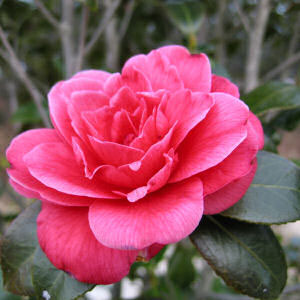Weekend Gardening: Caring For Camellias
March 8, 2014
One of Northwest Florida’s most reliable and rewarding shrubs is the camellia. Providing dark green leaves throughout the year, gardeners are rewarded in late winter or early spring with a variety of beautifully colored and shaped flowers. Camellias tend to thrive in our acidic soil but they do require some routine maintenance.
 Pick up the fallen flowers. A fungal disease known as petal blight will rapidly turn entire flowers brown. If a camellia has petal blight, remove and dispose of all blighted flowers both on the plant and on the ground. You may also consider discarding the old mulch around the shrub and apply a layer of fresh mulch. This practice sometimes helps prevent fungal spores from blowing back onto new flowers. One of the best ways to prevent this disease is to pick up and destroy fallen blooms. Flowers will continue to drop for several weeks, so it’s important to pick up blooms several times a week.
Pick up the fallen flowers. A fungal disease known as petal blight will rapidly turn entire flowers brown. If a camellia has petal blight, remove and dispose of all blighted flowers both on the plant and on the ground. You may also consider discarding the old mulch around the shrub and apply a layer of fresh mulch. This practice sometimes helps prevent fungal spores from blowing back onto new flowers. One of the best ways to prevent this disease is to pick up and destroy fallen blooms. Flowers will continue to drop for several weeks, so it’s important to pick up blooms several times a week.
Scout for tea scale. One of the most common insect pests of camellia is a scale insect known as tea scale. Check the underside of leaves regularly for this annoying pest. These small, sessile, white, thin, sap-sucking insects can build up large numbers if you do not regularly inspect your plants and take corrective measures when scale is first found. Often your first clue will be spotty yellowing on the upper surface of the leaves. Horticultural oil can be used in the winter time if used before blooming or in spring after blooming. Do not apply horticultural oil when near-freezing temperatures may be expected. Always carefully read and follow pesticide label directions before use.
Expect some leaves to fall in the spring. Camellias are “evergreen” meaning that they have leaves on the shrub year round. However, as individual leaves age, they will fall from the shrub and are replaced with new leaves in the spring. It is not unusual for camellia to drop up to 30 percent of their leaves. As long as new leaves are developing, there is no need for concern.
Camellia can be pruned after they flower. The most important reason for pruning camellias is to improve the overall health of the plant. Many times, camellias that have not been pruned in a few years will develop dead or deteriorating twigs. Removing the dead and dying limbs will minimize the possibility of diseases such as “dieback” and will also allow the plant to re-concentrate its energies. In many instances, camellias that have been neglected for a number of years will become infested with scale insects. Pruning is an effective way to provide for better coverage of chemical sprays and increase air circulation.
Lichens are warning signs. Lichens are gray-green to green mossy growths on the stems of old, neglected camellias. The lichen is a combination of a fungus and an alga that grows symbiotically. They are not parasitic to the camellia. Affected plants usually need fertilizing, watering, and mulching for better growing conditions.
Fertilizer applications help to achieve maximum performance. Apply fertilizer in the spring after blooming but before new growth starts. With many fertilizers, small amounts at frequent intervals are better than heavy applications. Special camellia fertilizers are available at your local stores. One application in early spring after blooming should be followed by a second application in mid June to early July. Scatter the fertilizer evenly on top of the mulch and away from the main stem of the plant. Water the fertilizer into the soil. Do not fertilize after July, so the plants will have a longer time to harden off and avoid freeze damage.
by Santa Rosa Extension Service
Comments
5 Responses to “Weekend Gardening: Caring For Camellias”



Don’t over prune or over fertilize. If you know how to air layer that is a good way to thin out the plants and multiply your plants. There are short films on You Tube to see how it is done. It is good to pick up dead flowers around base of plant. I found camellias a delight because I have not been successful in this area for carnations, peonies or roses and some varieties remind me of these that my grandmother grew.
Camellias also do not like full hot sun, they do best in dappled shade.
I have rose bushes that get this moss on them. It is green and I don’t know how to treat. On to something better, getting ready to put in summer garden and can’t wait!!!!!!!!!!!!!!!!!!
I have recently relocated and was happy to find three Camellias at my new residence. However, they have apparently been neglected for several years, so it will take pruning and care to get them in better condition. What is the best type of mulch to use for Camellias?
Is there a spray that will kill Lichens, this stuff get on all my trees and shrubs.